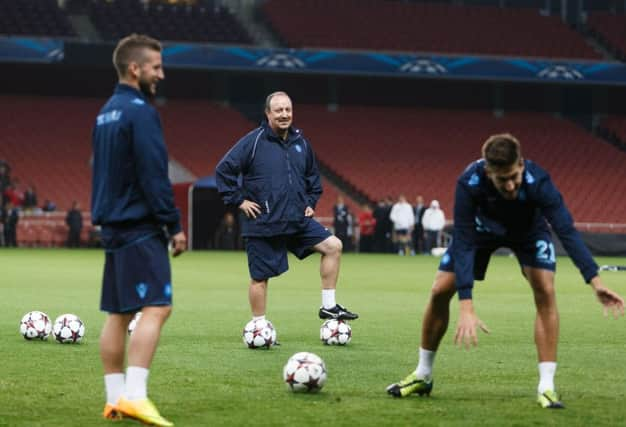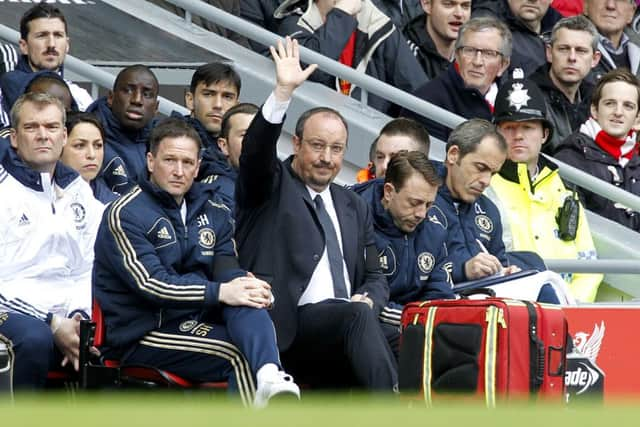Rafa Benitez: Training methods and tactics Newcastle players and fans can expect


The Spaniard has just 10 games left this season, and with Newcastle sitting in 19th spot and staring the Championship in the face, there is no margin for error.
Benitez will look to instill his ideas and philosophy on the Toon players over the forthcoming days and weeks, along with his backroom staff of Fabio Pecchia, Francisco de Míguel Moreno and Antonio Gómez Pérez.
Advertisement
Hide AdAdvertisement
Hide AdIn fact, his start was instantaneous, holding an impromptu training session with the players on their day off within an hour of being introduced to them.
But what can the players expect from him? And what style of football will Benitez play?
Firstly, Benitez has shown over his coaching career that he has a fine eye for detail and is a perfectionist, a meticulous planner and highly organised.
The Spaniard’s training sessions usually last 60-90 minutes, with a firm emphasis on exercises related to the game plan. So the preparation and tactics for the trip to Carrow Road on April 2 will differ from those used next week for the Tyne-Wear derby.
Advertisement
Hide AdAdvertisement
Hide Ad

And sessions will be based on the 80-20 philosophy that Benitez has used throughout his career – 80% of training with the ball and 20% without it where the players will work on essential fitness and muscular conditioning.
Given Newcastle’s lengthy injury record – a problem dating back years at the club – Benitez will look to modify the training accordingly, with players wired up to heart monitors and GPS during sessions.
For Benitez is no technophobe. He and his staff are firm believers in using the technology at their disposal to aid players in preparation for games and even during matches.
During his spell at Liverpool, Benitez was a firm advocator of Amisco, a Spanish analysis tool which has merged with Prozone, and Opta, where he would collate as much analysis and statistics as possible to feed to both his staff and the players ahead of games and to modify training sessions.
Advertisement
Hide AdAdvertisement
Hide Ad

He became such a disciple of analysis that Benitez began developing his own software, called Globall Coach, which he used used to prepare animations for coaching sessions, design exercises and monitor opponents around the pitch using an iPad or tablet.
Newcastle’s players will be fed information about opponents. How did the opponents line-up for corners last year? Did we have success at stopping them and how did we do it? The roles of individual players can be highlighted while the animation within the App allows the ideas to be shared quickly with the squad and changes made as appropriate.
And what about the style of play Newcastle fans should expect to see?
Benitez was one of the first proponents of the 4-2-3-1 formation which he used to great effect at Valencia, winning two La Liga titles and the Europa League. There, he played with the ‘double pivot’ of Ruben Baraja and David Albelda in midfield, both comfortable in possession and protecting the back four, a system he replicated at Liverpool with Xabi Alonso and either Javier Mascherano or Dietmar Hamman.
Advertisement
Hide AdAdvertisement
Hide AdHis teams have always played with a high tempo and ‘positive aggression’, pressing opponents in key areas across the pitch.
Benitez wants his teams to impose their style of play on their opponents and gain the initiative in games, but one of his key philosophies is the ability for his teams to be able to play different systems and styles when necessary.
Benitez has shown regularly an ability to switch tactics mid-game to get the best out of his team and combat what the opposition are doing.
The most famous of those was in the 2005 Champions League Final when, with Liverpool trailing 3-0 at half-time, he took off right-back Steve Finnan and went to a back three, with Finnan’s replacement Hamman operating as deep-lying defensive midfielder.
Advertisement
Hide AdAdvertisement
Hide AdThe result was instantaneous, with Liverpool coming back to win the game on penalties, which cemented Benitez’s place as a master tactician.
It wasn’t a one-off either. In the 2013 Europa League final, his half-time tactical switches gave Chelsea the upper hand over Benfica. Defender David Luiz revealed: “He changed some of our positions in the second half. That’s why we played better and won the title. He spoke a lot to us to change the intensity.”
Despite his success, Benitez has divided opinion with many fans due to a perceived negative style of play. He is not a fan of possession football just for the sake of it, a trait that seemed to blight Steve McClaren’s early tenure at Newcastle where the Magpies retained the ball without ever seeming to go anywhere with it. For Benitez, he is happy being more direct when needed.
One area he will look to improve the team, however, is in defence. An advocate of zonal marking – Valencia conceded the least amount of goals in the three seasons he used it there, while Liverpool conceded the least amount of goals from set-pieces two years in a row – Rafa must tighten up a rearguard that has shipped 53 goals already this season.
Advertisement
Hide AdAdvertisement
Hide AdThere’s plenty for Benitez to work on in the forthcoming days and weeks, not just tactically but also personally with the players.
At a coaching conference back in 2012, Benitez revealed the club values and team objectives he demands from his players, including that team interests must come before individual interests and respect must be shown at all times.
It’s a point he reiterated to the squad yesterday afternoon when he met them for the first time.
“All of us must push together in the same direction and with the same target in mind,” he said.
That target is survival – and the push starts now.